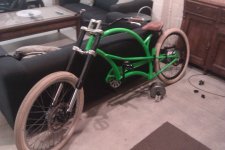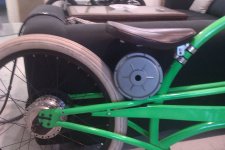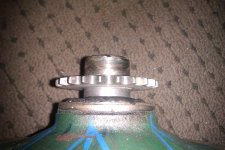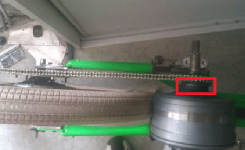Bluefang
10 kW
Hey guys and girls,
A while ago i bought one of the 93% efficiancy motors that John from CR was selling and i decided to mod it out to a reasonable level to allow me to push alot of power through the motor. Along with that i had a sample cruiser/chopper/lowrider bike that i imported from china that had some cosmetic damage to the frame so i can not sell it so been such a long bike it hopefully will be unable to flip me off the back with the large amount of power i am hoping to have.
With the motor i have had the flange cut off it so it can be used as a mid drive. With the switching mechanism in the motor it has been removed and i have moved one of the bearings inwards so i could mount a adapter to mount a sprocket on the motor case. The sprocket is 22T 219 high quality go kart chain and the rear will be ~90T. For the rear wheel atm it is a manual Nuvinci hub with the power running into the disk brake side of the hub, with its internal freewheel and robust design i hope it will survive(so i can pedal the bike if it ever brakes down or i need to go a long distance). The front and rear wheels atm are normal 26" rims and wheels but i anticipate changing the rim and tire on the rear to a 21" motorbike combo and changing the front wheel to a 29" bicycle DH wheel with a 12mm axle and moto disc for braking.
http://www.endless-sphere.com/forums/viewtopic.php?f=31&t=40859

View attachment 2
View attachment 1

A while ago i bought one of the 93% efficiancy motors that John from CR was selling and i decided to mod it out to a reasonable level to allow me to push alot of power through the motor. Along with that i had a sample cruiser/chopper/lowrider bike that i imported from china that had some cosmetic damage to the frame so i can not sell it so been such a long bike it hopefully will be unable to flip me off the back with the large amount of power i am hoping to have.
With the motor i have had the flange cut off it so it can be used as a mid drive. With the switching mechanism in the motor it has been removed and i have moved one of the bearings inwards so i could mount a adapter to mount a sprocket on the motor case. The sprocket is 22T 219 high quality go kart chain and the rear will be ~90T. For the rear wheel atm it is a manual Nuvinci hub with the power running into the disk brake side of the hub, with its internal freewheel and robust design i hope it will survive(so i can pedal the bike if it ever brakes down or i need to go a long distance). The front and rear wheels atm are normal 26" rims and wheels but i anticipate changing the rim and tire on the rear to a 21" motorbike combo and changing the front wheel to a 29" bicycle DH wheel with a 12mm axle and moto disc for braking.
http://www.endless-sphere.com/forums/viewtopic.php?f=31&t=40859

View attachment 2
View attachment 1












